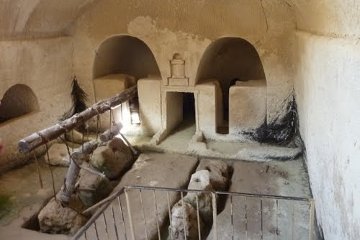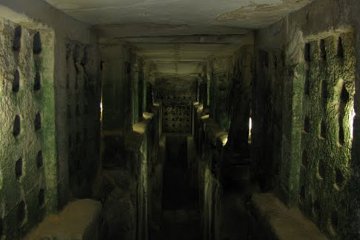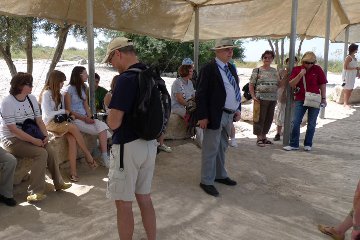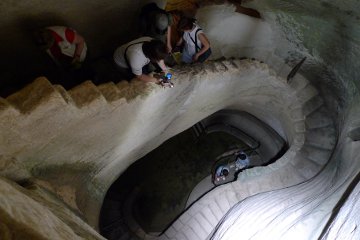Digging Mareshah
| Mareshah | 31 35 28.22N 34 53 50.49E | The coordinates are the approximate location of the cistern in which we were digging. |
For several years now our annual dig has been on Tel Mareshah, a site that has been lived on continuously from Biblical times to the present.
Mareshah is mentioned as one of the cities that fell to the Israelite conquest under Joshua about 1400 BC (Josh 15:44). It is again mentioned during the reign of Rehoboam, son of King Solomon, as one of the cities he fortified for defence (2 Chron 11:5-8). In the 9th century BC, Zerah the Ethiopian (whose identity is not certain) attacked Judah. Against a far superior Egyptian army, King Asa and his army marched 25 miles from Jerusalem to Mareshah and won the battle (2 Chron 14:8-10).
After the Babylonian conquest and the destruction of the temple in 586 BC, the area of southern Judah was settled by the Edomites. Joining them were settlers from Sidon, in Phoenicia. Two burial caves belonging to the Sidonians have been discovered in Mareshah, including that of Apollophanes, son of Sesmaios, the leader of the Sidonian community.
From the time of Alexander the Great, Greek settlers brought their Hellenistic culture to Mareshah. Located on an important north-south highway, the city became a prosperous economic centre. Other main roads led down to the Mediterranean coast and up through the hills to Hebron and Jerusalem.

| |
| View towards the coast from Mareshah. Usually when we are there the hillside is brown and dry and a crop of wheat is ready for harvest in the valley. |
Ancient Mareshah was located on the summit of a tel from which a 360 degree view extends over the lowlands of Israel (known as the Shephelah) to the west and up into the highlands of Judea to the east.
Growing olives and producing olive oil was an important industry. In fact, it still is, and the hills around are dotted with olive groves, just as in ancient times. Olives are harvested in the autumn (October/November) and were an important food item, while the oil was used for lighting, beauty products and in religious services. The dried mash left over after crushing was burned for cooking and heating.
The thin soil at Mareshah lies over a layer of hard limestone rock known as nari that is 2-3 metres thick. Beneath that is a soft limestone called kirton which is suitable for construction. To obtain building stone, the workmen dug a small hole through the hard stone and then quarried underground into the soft limestone. In this way they excavated huge underground chambers beneath the city, many of which are connected underground to form immense cave systems. The quarried rock was brought to the surface where it was used for building houses, while the caves were utilised for other purposes.

| |
| A typical oil processing unit at Mareshah, showing the oil press with a reconstructed beam and original weights. |
Many caves were basement storage areas for the houses above. Others were lined with plaster and became huge water cisterns. Some caves were set up as workshops or small factories. Cool in summer and warm in winter, the caves could be easily blocked up to prevent rats and other vermin from entering.
In many caves, archaeologists found oil presses for extracting olive oil. So many oil presses have been discovered that archaeologists have surmised that Mareshah was a major centre for olive oil production for the whole country. The olives were crushed in a large circular stone press on which a round stone was rolled. A long handle through the middle of the stone was attached to a pivot in the middle of the press. The olive oil was run off into vats nearby. The olive mash was then packed in wicker bags and crushed again, this time under a wooden lever weighted with a series of heavy stones.
Another important industry at Mareshah was the rearing of doves or pigeons. These were an important food source, and in addition, poor people who could not afford a lamb offered pigeons as sacrifices in the Temple in Jerusalem. A by-product of pigeon rearing was the dung, which was used as fertiliser. The pigeons roosted in underground caves known as columbaria. Niches in the walls served as nesting boxes, and even today, many of these caves are still filled with pigeons.

| |
| The large dove cote referred to in the article, seen from the entrance, some 25 feet above the floor. |
The largest underground pigeon coop found at Mareshah is open to visitors. The cave was cut into the soft rock in the form of a double cross more than 160 feet long and 25 feet high. In the walls are more than 2,000 niches. At Mareshah, 85 such caves have been discovered and altogether, tens of thousands of pigeon roosting niches have been found.
Our 2003 dig was inside another underground cave discovered only three years previously. Although hundreds of caves have been found around the ancient city, more are still being discovered. The cave we were excavating is one of a series of interconnecting caves, all dug in the 3rd-2nd centuries BC. Large rooms were hollowed out, leaving rock pillars to support the roof. Shelves, storage bins, niches for oil lamps as well as shrines for worship were cut into the cave walls.
When discovered, dirt and rubbish filled the cave to within a foot of the roof, but over the last 3 years, successive excavation teams have lowered the floor level by about 7 feet. Our first task was to find out how much more dirt was left above the original floor. An earlier team had started digging an exploratory pit, 6 feet long and 3 feet wide, at one end of the cave. On the first day, we finished off their work, striking bedrock about 6 feet below the present level of dirt. As a result, we estimated the chamber was originally about 18 feet high. It encouraged the Israeli archaeologists in charge of the site that they were at least about half way through the job.
Our real work was to explore a niche and small opening exposed at one end of the cave system. Digging had uncovered a recess in the wall of the cave, still partly covered in dirt. The recess was about three feet wide, curved at the back and arched up to a point. Steve and I decided to find out what was at the bottom of the recess.
Gathering empty plastic buckets, we each selected a hoe that is the universal archaeological tool in Israel, and started digging or rather scraping. We used the flat blade of the hoe to scrape in inch or two of soil towards us and scoop it into the bucket between our feet. In the process, we kept a sharp eye for broken pottery, bones, coins, jewellery or other objects.

| |
| My group at Mareshah relaxes in the shade while I explain about the caves. |
A few days earlier another group digging nearby had found several clay penises, erect and slightly larger than life size, that were evidently fertility symbols. Since the penises were circumcised, archaeologists assumed they belonged either to Jewish people living in the area, or foreigners influenced by Jews to practise circumcision.
The earth in the cave was soft and unconsolidated since most of it was fill that was deliberately dumped in the cave, possibly when the city was destroyed in the mid-first century BC or when the site was cleared for rebuilding in the first century AD. There was no stratification in the fill, and archaeologists working at the site are convinced the fill was dumped at one time since the pottery is all from the same era.
Digging in a cave was by no means a normal dig. Usually we measure out a 15' x 15' square and dig down only in the area between the baulks or walls of the square. We carefully examine the different strata, or layers, of soil, which make up the various civilisations. From the layers, built up over hundreds, or even thousands of years, the history of the site can be written. But in our cave, such a method was pointless, since the fill only represented one short era in Mareshah s history. Digging the soft soil was easy although lumps of rock sometimes had to be lifted up and placed on the edge of the pit in which we soon found ourselves.
In the soil we found many hundreds of pieces of broken pots. While many pottery sherds had no distinguishing features, others were diagnostic specimens, with handles or spouts. Some pieces were rims of jars or cooking pots, while others were complete round bases. Here was the civilisation of those times: cooking pots and water jars, storage vessels with large handles, and miniature juglets with elongated necks and delicate handles. Although we did not find any complete vessels, we found enough broken pieces to conjure up in our minds a vast array of kitchen and dining ware.
One piece of pottery was unusual. It was part of the neck and flared rim of a jar that had been fired at a higher temperature. Decorative markings in the glaze around the opening indicated it was part of a vessel imported from Greece. Much more expensive than local pottery, it indicated the Greek influence that dominated Mareshah in the 3rd-2nd cent BC.

| |
| Members of my tour group explore one of the cisterns beneath Mareshah. |
After we filled all the buckets we could lay our hands on, we formed a chain to carry them up a rickety, homemade ladder, 16 feet long, to the surface. Each bucket was then sieved to separate the dirt and stones and reveal any pottery or other smaller items we may have missed in the semi-darkness of our work area. John pored over the sieve and continually delighted us by holding up the objects his sharp eyes found in the buckets of dirt.
In addition to the many pieces of pottery, we found the bones of food animals, such as chicken or sheep. Since no pig bones have been found so far, the evidence suggests that Jews, or other people who adopted Jewish dietary practices, inhabited Mareshah. However as in most ancient cultures, meat was expensive and not consumed regularly and the staple items of diet were cereal-based, along with vegetables and fruit. On the second day of the dig our hoes turned up the top half of an oil lamp that had been produced in a mould. Originally oil lamps were made by hand. But later lamps were mass-produced using moulds - the clay was pressed into two moulds, one for the bottom half to form a shallow bowl, and the other for the top half. When the clay was dry, the two halves were joined together with wet clay and then fired in a kiln.
But our excitement was much greater a few hours later when we turned up what turned out to be the find of the whole dig, another oil lamp. This one was complete and its upper surface bore a simple geometric design, barely visible under the dirt. On one side was a small projection, part of a handle. Olive oil was placed in the bowl through the large round opening, while a wick of cloth was inserted in the small hole at one end and lit. The lamp would have provided dim, but adequate light in the homes for several hours at night.
We dug an area nearly six feet square down about three feet. Suddenly, the loose brown soil came to an abrupt end, and we began to dig in harder, white limestone. By this time we had exposed the niche. At the base was a flat, square shelf into which was cut a horizontal square opening. One side of the opening was cut another 8" lower, forming a step that led down into another, deeper cave inside. The lower cave was completely filled with dirt.
Access to the second cave was difficult. We kept bumping our heads on the curved walls of the niche, and bending down through the opening was back-breaking work. But as successive bucketfuls of dirt were lifted out, the room under the shelf widened into a semi-circular, bell-shaped chamber. There was just room for one of us to crawl through the opening and into the lower cave. Here it was even darker than the upper cave. Lying in the dirt, covered in dust and muddy sweat, we took it in turns to dig by the light of a feeble torch or in the dim light percolating from the upper cave through the opening. Just as well neither of us suffered from claustrophobia!
On one side of the lower chamber, a small opening led into another cave. Over the previous year or two, robbers had dug in that cave looking for unbroken pottery vessels to sell. The archaeologists cannot stop the looting, and although the caves are within a national park, they are unguarded and open at all hours. There is just too much to protect, and archaeologists can only hope they are one step ahead of the looters. Often the robbers find the new tombs and caves and the archaeological department is continually mounting rescue digs to limit the loss.
Because the adjacent cave was unexcavated, the soil and stones coming through the opening into our excavation made full clearance impossible. We opted for a partial excavation on one side of the cave. After digging a small trench about three feet deep we finally reached the bottom of the chamber. Now we could see that the semi-circular chamber was about 5 feet wide and 6 feet deep. The bedrock floor sloped from the back to the front. Like similar chambers found in the area, our cave was probably used for grain storage during the time of Mareshah's greatest period of occupation (4th - 2nd centuries BC). A large blocking stone would have covered the square opening at the top. But the unusual step was a puzzling feature never seen before.
The prosperity of Mareshah came to an end in 113 BC. John Hyrcanus I, the Hasmonean ruler, conquered Mareshah and forced the residents of the city and surrounding villages to convert to Judaism. The city was destroyed and left in ruins. The latest coin discovered from this period is dated to 108 BC. When the area was resettled a few years later the population was sparse, but according to Josephus, the Parthians destroyed the city in 40 BC.
The city of Beit Guvrin replaced Mareshah. Built a couple of kilometres from the tel, down in the valley beside a stream, Beit Guvrin was a flourishing Jewish town in the first century AD. By AD 200, it became a Roman city, boasting a huge amphitheatre for gladiatorial combats and a large bathhouse, without which no self-respecting Roman could live. Two aqueducts supplied the city s water. The emperor Septimus Severus changed name of the city to Eleutheropolis (City of the Free) and granted it municipal status.
Because of its location on a major road junction, Beit Guvrin remained important. By the Byzantine era (AD 324-640) the city had a large synagogue as well as numerous Christian churches. When the Crusaders came they built a large castle over the foundations of the Roman bathhouse. Part of the castle included a basilica-type church. Both the castle over the bath house, and the church have been partly restored for modern tourists today who wander through the confusion of buildings built over top of each other.
An Arab village occupied the site until 1948 when the Israelis captured the area. The Beit Guvrin kibbutz was established nearby the following year. Our group stayed in the kibbutz guest rooms for the week of the dig. The area is rural and peacefully idyllic, with extensive views over rolling hillsides, many of them reforested. Our group enjoyed not only working at Mareshah not far from the kibbutz, but also visiting other local sites in the vicinity, including the ruins of Lachish. One of our group members even attended an Israeli folk concert held in the ancient amphitheatre of Eleutheropolis.
If you have the spirit of adventure and think you would enjoy the excitement of making archaeological discoveries, then you are welcome to join us on our next dig. We are planning to return to Mareshah in May 2004 at the end of our three-week tour of Egypt, Jordan and Israel. You may take the tour and stay for the dig, or just join us for the dig only. Although you need to be fit, you do not need any experience or skills and there is no age limit. And you don t have to be as energetic as Steve and I! There is something to do for all age groups and you can work at your own level of fitness, and at your own speed. There are a number of different jobs that can be done, for both men and women.
For details of our latest tour visit our tour page.





